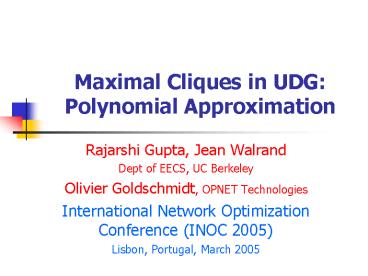Maximal Cliques in UDG: Polynomial Approximation PowerPoint PPT Presentation
1 / 15
Title: Maximal Cliques in UDG: Polynomial Approximation
1
Maximal Cliques in UDG Polynomial Approximation
- Rajarshi Gupta, Jean Walrand
- Dept of EECS, UC Berkeley
- Olivier Goldschmidt, OPNET Technologies
- International Network Optimization Conference
(INOC 2005) - Lisbon, Portugal, March 2005
2
Unit Disk Graph
- Geometric graph on a plane
- Two vertices are connected iff their Euclidean
distance is ? 1 - Common application in wireless networks
3
UDG in Wireless Networks
- Wireless nodes are connected if they are within a
transmission radius - Assume all nodes have same transmission power
- Then underlying graph model is UDG
4
Cliques
- Cliques in a graph
- Clique Complete Subgraph
- Maximal Clique is not a subset of any other
clique
- Capacity and cliques
- Clique Set of nodes that all interfere with
each other - Observe cliques in wireless graphs are local
structures
5
Problem Formulation
- Given UDG on a plane
- Each vertex knows its position
- Also knows position of neighbors
- Want to compute all maximal cliques in the
network
6
General Clique Algorithms
- Well known problem in Graph Theory
- Harary, Ross 1957
- Bierstone 1960s
- Bron, Kerbosch 1973
- Given any graph G(V,E), generate all maximal
cliques - Exponential number of maximal cliques in general
graph - So these algorithms are exponential and
centralized - Exponential number of maximal cliques even in UDG
? - Hence want approximation algorithm that is
- Localized, Polynomial and Distributed
7
Approximating Maximal Cliques
- For each edge uv in UDG
- Length of edge uv duv
- Output all cliques with edges ? duv
- This will output all maximal cliques
- Football Fuv contains all cliques
- Disk Duv forms a clique
- Curved Triangles T1uv T2uv form cliques
8
Bands
- Consider Band of height duv within Fuv
- For each vertex in Fuv position a band lying on
the vertex - Theorem All cliques in Fuv included in set of
bands Buv - Consider any clique q, and let x be its vertex
farthest from uv - Since x is farthest, all other vertices must lie
on same side of x as uv - But distance from x to all other vertices lt duv
- Hence all these vertices also lie in this band
- Note Band Buv may include extra vertices. Hence
approx algo.
9
Basic Algorithm
- For small bands, single clique includes all
vertices - Else we try the three cliques we know
- Need to resort to bands only as a last resort
- Takes O(?) to generate clique
- Order of algorithm O(m?2)
- m number of edges
- ? max degree of graph
- Number of cliques O(m?)
- if duv ? 1/?3
- output clique Fuv
- else
- output cliques Duv, T1uv, T2uv
- if all vertices in Duv, T1uv or T2uv
- we are done
- else
- output Buv by positioning band at each
vertex in Fuv
Algorithm is localized and distributed
10
Modified Algorithm
- Consider shapes D1uv, T11uv, T21uv of dimension 1
instead of duv - These form cliques that are supersets of Duv,
T1uv, T2uv - If duv ? ?3 1, every band is contained in
either T11uv or T21uv - Worst case running time same, but improves
average case
Modifications if duv ? ?3 - 1 cliques T11uv,
T21uv enough else if all vertices in D1uv,
T11uv, or T21uv we are done else use bands
Buv as before
11
Cliques per Edge
- Simulation details
- 10X10 field
- 100 to 2000 nodes
- Each point average over 10 simulations
- Observations
- ? increases linearly with node density
- No. of cliques/edge also rises linearly
- Actual cliques only 1/8 or 1/10 of m?
per edge
12
Clique Computation Methods
- Four methods of computing
- d lt 1/?3
- d lt ?3-1 (modified)
- D, T1 and T2
- Bands
- Observations
- More bands at denser networks
- Modified algorithm reduces reliance on bands
- Left bar Basic algorithm
- Right bar Modified algorithm
13
Changes in Network
- Complexity analysis
- Change affects neighborhood of one/two nodes
- May have O(?2) edges
- Recomputing cliques at each edge takes O(?2) time
- Total algorithm is O(?4)
- Note that O(?2) ? O(m), so no worse than O(m?2)
- Want all changes to be handled locally and
efficiently - New vertex O(?4)
- Delete Vertex O(m?)
- New Edge O(?4)
- Delete Edge O(?4)
- Move Vertex O(?4)
14
Conclusions
- Motivation
- Cliques in Unit Disk Graphs common in wireless
networks - Background
- Number of maximal cliques is exponential
- Rely on approximation algorithm
- Algorithm Summary
- Consider each edge, and find all cliques with
this as the longest edge - Limit clique-forming vertices into characteristic
shapes - Runs in O(m?2) time, generates O(m?) cliques
- Distributed, localized and polynomial algorithm
15
Questions ?
- http//www.eecs.berkeley.edu/guptar
- guptar_at_eecs.berkeley.edu

